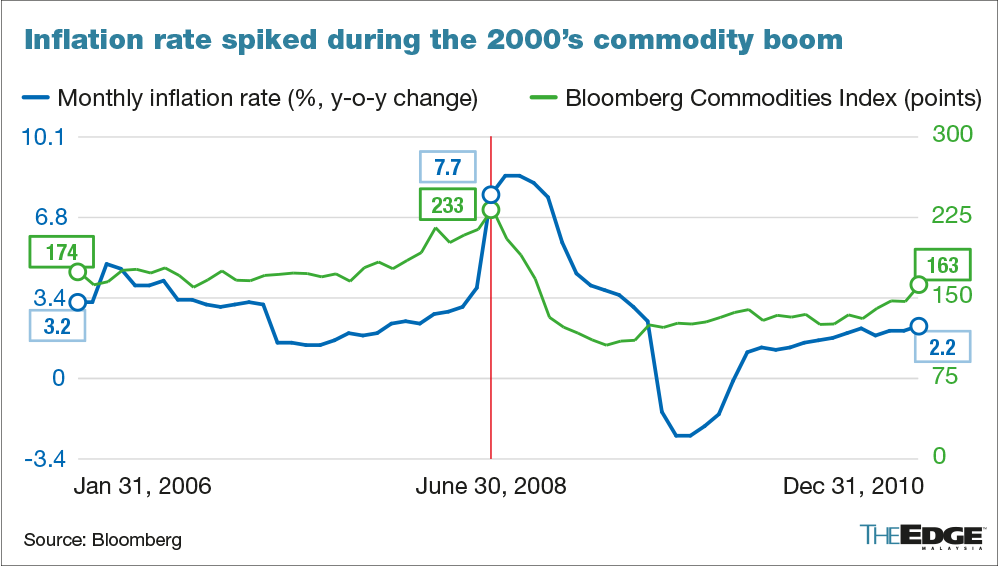
KUALA LUMPUR (May 11): The recent continuous climb of commodity prices to multi-year highs may soon creep into prices of other goods and services, economists said.
However, the rise may be temporary, they said, citing risks from the resurgence in Covid-19 cases on global economic recovery, which could put a lid on demand.
In a written reply to The Edge, MARC chief economist Firdaos Rosli opined that the commodity boom was triggered by optimism due to improved economic numbers, ample supply of stimulus, and low interest rates.
"We think inflation could only happen due to either the low base effect or any unforeseen exogenous supply shocks," explained Firdaos.
"The former is short-term and will unlikely to be damaging in the long run. The latter, however, could thwart recovery momentum amid slow vaccine roll-out in Malaysia and most parts of the world.
"In any case, inflation in the near term would likely be cost-push and transitory as we are not out of the woods yet with Covid-19," Firdaos said.
Malaysian Institute of Economic Research (MIER) senior research fellow Dr Shankaran Nambiar concurred.
"The rising commodity prices will find their way into the prices of other goods and services, resulting in higher inflation.
"Most of the expectations for growth are contingent on the pandemic waning and on global demand recovering. But that is not to say that uncertainties have been laid to rest," Dr Shankaran said.
"To the contrary, the risk of further waves of Covid-19 striking is still present on the horizon," he added.
Prices on the rise
Recall that the last commodity bull market in the 2000s spanned a good half of a decade, mainly supported by rising demand from emerging markets and China's rise as a key economic power.
At its height, Malaysia's monthly inflation rate jumped above 8% between July and September 2008 (see chart) while Bank Negara Malaysia's (BNM) overnight policy rate (OPR) stood at 3.5%.
The annual inflation rate climbed to 5.4% in 2008, from 2% in 2007 and 3.6% in 2006.
This time, prices of commodities from copper to crude palm oil, petrochemicals and even cotton have jumped past pre-pandemic levels, supported by supply shocks, pent-up demand and stockpiling led by China's recovery. Some even scaled new highs this year.
Demand may also see support from infrastructure pump-priming, from the US to Malaysia, which is expected to digest incoming supply.
Some have downplayed inflation risks by pointing to spare supply capacity in the markets, and pointed to how prices of final products are now much less sensitive to commodity price fluctuations compared with a decade ago.
But companies and investors have already prepared for a higher inflation world, MIDF Research economist Abdul Mui'zz Morhalim said.
"PMI surveys for most countries highlighted that firms in the manufacturing and services sectors reported rising input costs due to shortages of raw materials and challenges from logistics and transportation," said Abdul Mui'zz.
"Consequently, selling prices have been raised as companies passed some of the increased costs to the clients," he added.
Indeed, global shipping freight rates are currently at the highest in over 11 years.
At home, Fraser & Neave Holdings Bhd (F&N) said its commodity input costs have risen by 15%-75% from April 2020, and that it may increase prices, depending on product categories.
Poultry farmers have flagged rising feed costs by 20% from April 2020, resulting in the imposition of ceiling prices over poultry by the government. Similarly, it has also put a ceiling on local petrol and diesel prices, which has put a lid on transport inflation.
Year-on-year, the consumer price index rose 0.1% in February and 1.7% in March 2021, marking a reversal from the negative rates since March 2020 when the first lockdown occurred.
It is worth noting that in Malaysia, the three components with the biggest weightage in the headline inflation rate make up 67.7% of total, comprising food and beverages (30.2%), housing and utilities (23.8%), and transport (13.7%).
BNM in its Economic and Monetary Review 2020 report projected the headline inflation to average at 2.5%-4% in 2021.
In its latest monetary policy statement, BNM maintained that "underlying inflation is expected to remain subdued amid continued spare capacity in the economy".
"The outlook, however, is subject to global oil and commodity price developments," said the central bank as it maintained the OPR at 1.75%.
MARC's Firdaos opined that "fiscal policy would do most of the heavy lifting" in addressing price hikes before the unemployment rate goes back to pre-pandemic levels.
BNM's governor Datuk Nor Shamsiah Mohd Yunus will be releasing the first quarter economic figures including the gross domestic product number today (Tuesday, May 11). The governor will be able to shed some lights on whether inflation pressure is building up. Will inflation hinder the recovery, not to mention the resurgence of Covid-19 cases?

